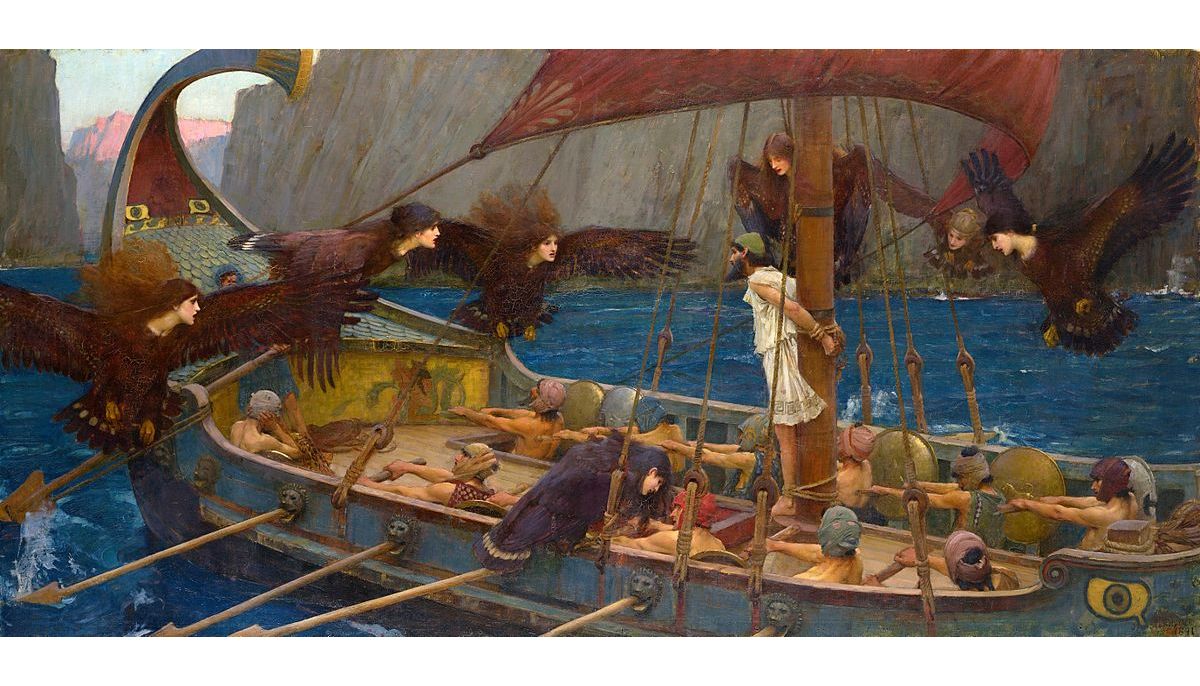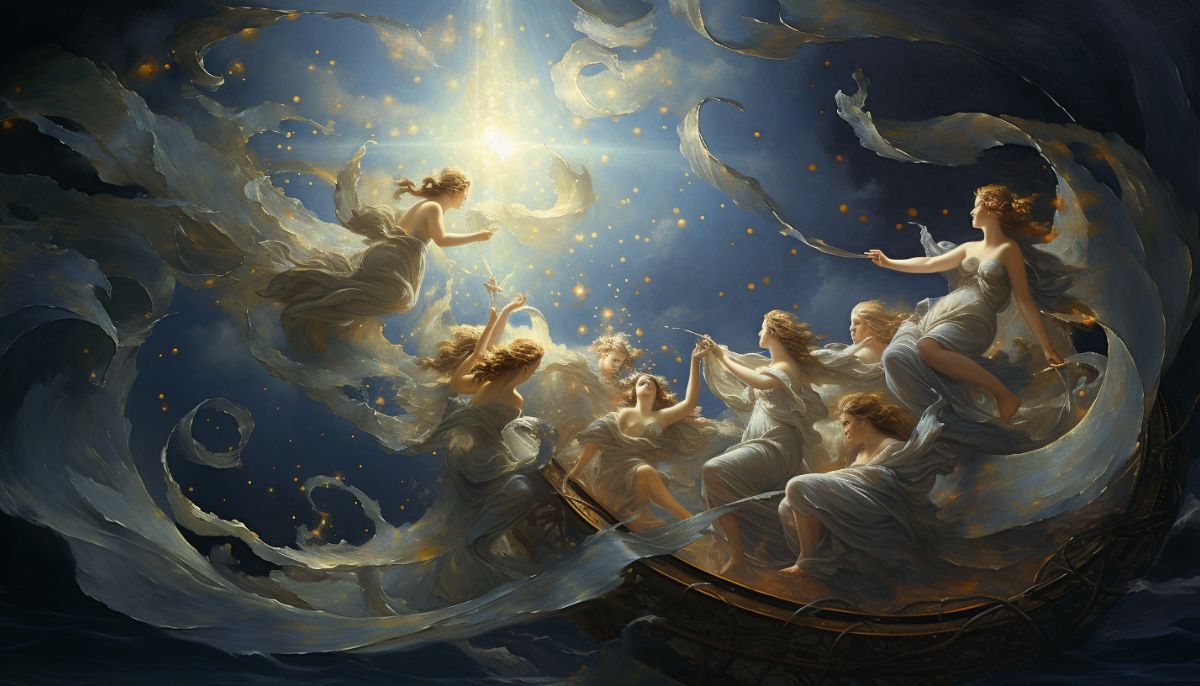In the labyrinthine tapestry of Greek mythology, few figures evoke as much fascination and intrigue as the enigmatic sirens. With their tantalizing songs and bewitching allure, sirens have woven themselves into the fabric of ancient lore, leaving an indelible mark on our collective imagination.
This exploration ventures into the depths of siren mythology, untangling the threads of their origins, delving into their famous encounters, and deciphering the enduring symbolism they represent.
Join us on a voyage through the captivating realm of sirens, where the boundaries between mortal and divine blur, and the call of the unknown beckons with a haunting melody.
What do Sirens look like?
Initially, the Seirenes, or Sirens, were envisioned as creatures with either the heads or entire upper bodies of women, seamlessly fused with the graceful plumage and legs of birds. This distinctive imagery set them apart from the conventional mermaids that often populate maritime lore.
Are Sirens Mermaids or Birds?

The Seirenes’ unique portrayal veers away from the conventional mermaid archetype. While mermaids are typically envisioned as humanoid creatures with fishtails, the Seirenes defy this convention by incorporating avian characteristics. This distinction sets them apart, placing them in a category of their own within the realm of mythical beings.
The ancient Byzantine dictionary, Suda, dated back to the tenth century, intriguingly described sirens as creatures with the form of sparrows from their chests up, while below, they exhibited a distinctively human or avian appearance. An alternate interpretation suggested they were diminutive birds bearing the countenance of women.
Originally, sirens were depicted in both male and female forms. However, as time progressed, the portrayal of male sirens gradually faded from artistic representations, a transformation that took place around the fifth century BC.
Early Siren-Mermaids Emergence
In some surviving Classical period depictions, sirens began to take on mermaid-like characteristics. Notably, examples dating back to the 3rd century BC portrayed them as mermaids or “tritonesses”. This transformation is evident in artifacts such as an earthenware bowl discovered in Athens and a terracotta oil lamp, believed to be from the Roman period.
The first documented literary reference to sirens as “mermaids” surfaced in the early 8th century AD within the Anglo-Latin catalogue, Liber Monstrorum. Here, sirens were described as “sea-girls” possessing the body of a maiden, yet adorned with scaly fishtails, signifying a pivotal shift in their visual representation.
Greek Siren Mythology
In the rich tapestry of Greek mythology, sirens emerge as fascinating creatures, their existence entwined with the vast expanse of the sea.
The Origins of Greek Sirens
Their origin stories are as diverse as the realms they are said to inhabit, with various sources weaving intricate narratives around these beguiling creatures.
Ovid’s Sirens
According to the verses of Ovid, Demeter, the goddess of harvest and fertility, bestowed upon the sirens a set of wings.
This gift was intended to aid them in their quest to locate Persephone, whom the enigmatic Hades had spirited away. However, a different rendition in the Fabulae of Hyginus offers a contrasting perspective.
Here, Demeter, aggrieved by the sirens’ perceived inaction during the abduction of Persephone, casts a curse upon them. According to this account, the sirens’ fate is inexorably linked to mortals: they shall exist only until the day those who hear their haunting melodies manage to pass them by.
Sirens and the Muses
In another captivating legend, Hera, the venerable queen of the gods, orchestrates a singing contest between the sirens and the Muses, the nine goddesses of inspiration.
The outcome tips favor the Muses, who, triumphantly, proceed to pluck every feather from the sirens’ forms. These feathers, transformed into exquisite crowns, are stark reminders of the sirens’ resounding defeat.
In his poetic rendition, Stephanus of Byzantium narrates that the crestfallen sirens, their plumage gone, turn as white as the sea foam and descend into the waters off Aptera. Thus, they become the islands known as Leukai, or “the white ones,” in modern parlance.
The Sirens of the Argonautica
In the ancient Argonautica, a narrative dating back to the third century BC, the wise centaur Chiron delivers a prophetic message to Jason. It foretells the importance of Orpheus, the famed musician, on their arduous journey.
When the dulcet tones of the sirens reach Orpheus’ ears, he deftly wields his lyre, weaving a melody more enchanting than theirs. His music drowns out their seductive songs, sparing the crew from their perilous allure.
Yet, it is the sharp-eared hero, Butes, who, ensnared by their melodies, takes a fateful leap into the sea. Here, he is cradled by the goddess Aphrodite and spirited away to safety, escaping the sirens’ bewitching grasp.
Odysseus and the Sirens

In the epic Odyssey, the cunning Odysseus finds himself on an odyssey of his own, navigating treacherous waters and facing mythical perils.
Circe’s counsel prevails when the alluring strains of the sirens beckon to him. Odysseus commands his crew to plug their ears with beeswax and, with unwavering resolve, he orders himself to be tethered to the mast of his ship.
Despite his entreaties, he insists they keep him bound, resolute in his desire to hear the sirens’ song. It is a testament to his men’s loyalty that they remain steadfast.
As the haunting melodies wash over him, Odysseus, enraptured, implores to be set free. Yet, they tighten his bonds, ensuring his safety.
Post-Homeric accounts suggest that the sirens, destined to meet their end should a listener elude them, chose to fling themselves into the sea after Odysseus’ passage, meeting a tragic fate.
Pliny’s Skepticism
In the annals of Roman antiquity, the erudite Pliny the Elder offers a more skeptical viewpoint.
He dismisses the sirens as creatures of pure fable, relegating them to the realm of myth and imagination.
Even as Dinon, the esteemed progenitor of Clearchus, claims their existence in the distant lands of India, describing their captivating songs that lull men into slumber before a grisly fate, Pliny maintains a measured skepticism, questioning the veracity of such accounts.
Famous Greek Sirens
Parthenope, Ligeia, and Leucosia: These three sirens claimed the rocky shores of Ischia as their domain in the Tyrrhenian Sea. According to ancient lore, their hauntingly beautiful voices lured sailors to their doom, their songs weaving a mesmerizing spell that left ships wrecked upon the unforgiving rocks.
Each of these sirens carried her own distinct aura of enchantment, yet together, they formed a trio whose legacy has endured through the ages.
Parthenope: The Siren of Fateful Temptation
A poignant tale of unrequited desire marks Parthenope’s prominence in Greek mythology. Despite her alluring charms and beguiling song, she faced the ultimate rejection from the cunning Odysseus.
Faced with this heart-wrenching failure, Parthenope made a fateful decision. She relinquished the world above, willingly descending into the depths of the sea, where she found solace in the waves’ embrace, forever becoming a part of its eternal rhythm.
Her story is a haunting reminder of the sirens’ powerful, yet often tragic, allure in ancient Greek narratives.
Ligeia: The Enchanting Siren of the Seas
Ligeia, the Siren, bore a lineage intertwined with the very essence of the natural world.
Born of the union between the river-god Achelous and the Muse Melpomene, or potentially her sister Terpsichore, Ligeia was part of a trio of sirens, joined by her sisters Parthenope and Leucosia.
This enigmatic trio found their earthly abode on the shores of Terina in Bruttium, now known as the modern region of Calabria.
Leucosia: The Siren of White
In the pantheon of Sirens, Leucosia emerges as a figure of singular distinction. Born of the union between Achelous and Melpomene, or possibly Terpsichore, she too was part of the trio with Parthenope and Ligeia.
Her name, derived from the Greek word for ‘white’, befits a siren whose mystique was as pure and alluring as the driven snow. It is whispered in ancient lore that her body was discovered on the shores of Poseidonia, leaving an indelible mark on the annals of maritime legend.
The island opposite the cape of the Sirens, forever bears the name Leucosia, a testament to the enduring power of her enchantment.
Common Tropes and Symbolism of Sirens
Sirens embody a range of enduring tropes within Greek mythology. Often depicted as half-woman, half-bird creatures, their ethereal allure has become an archetype for temptation and allure.
This duality, with avian features juxtaposed against a seductive female form, encapsulates the conflicting nature of desire and danger that sirens represent.
The symbolism of sirens extends beyond their physical forms. Their haunting songs are often interpreted as metaphors for the allure of the unknown, the irresistible call of distant shores, or the all-encompassing power of desire. In this sense, sirens serve as a cautionary tale, reminding us of the perils of succumbing to our basest instincts.
Similar mythological creatures to Sirens
In the broader tapestry of Greek mythological creatures, sirens find companionship with other elusive beings. They share a sense of untamed wilderness with the Harpies, embodying nature’s unpredictable and sometimes perilous aspects. Are Sirens and Harpies the same?
Similarly, like the enchanting nymphs, sirens represent the profound connection between nature and the supernatural world, blurring the lines between mortal and divine realms.
As with many Greek monsters, sirens challenge conventional notions of beauty, blurring the boundaries between the monstrous and the enchanting.
Through their complex symbolism, they beckon us to navigate the intricate web of human desires, reflecting on the soul’s profound, and sometimes perilous, journey. In the realm of Greek mythology, sirens stand as enduring figures, weaving their enigmatic song into the rich tapestry of ancient lore.
Want to know more about the creatures and monsters of Greek Mythology?

Explore more articles like this in our broader series on Greek monsters. To delve even deeper into the world of mythical creatures, be sure to check out our comprehensive hub article on the monsters of Greek mythology.






